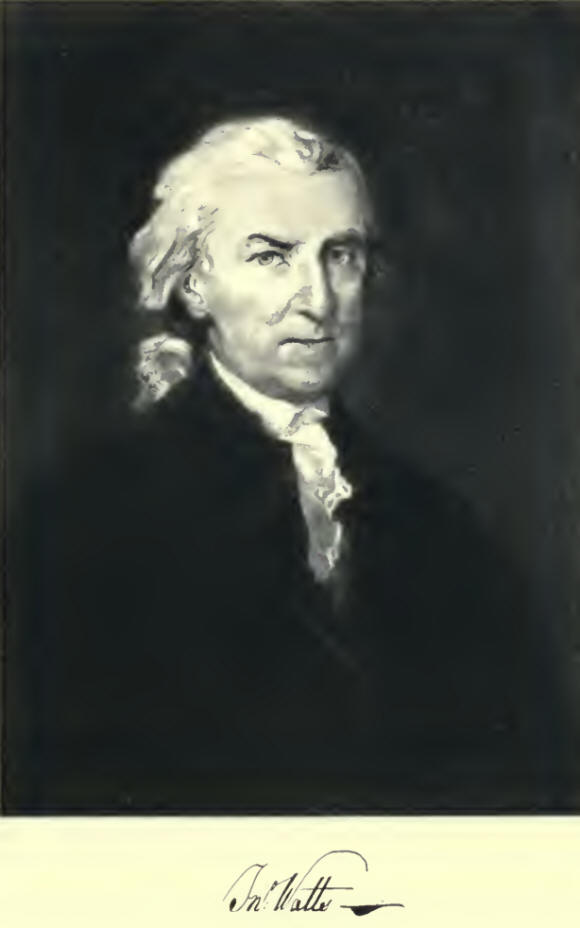|

Tenth President
1771-1772.
John Watts of Rose Hill,
Edinburgh, Scotland, was the ancestor of the Tenth President of Saint
Andrew’s Society, and his second son, Robert Watts, was the first of his
name in the Colony of New York.
John Watts, the
President, the son and fourth child of Robert Watts and Mary Nicholl,
was born on the 16th April, 1715, in the City of New York, and died in
the month of August, 1789, in Wales, being buried in St. James Church,
Piccadilly, London.
Possessing every
advantage of birth and education, and closely allied with the
representative Colonial and Provincial families, Mr. Watts, even as a
young man, took a leading position in the business and social community.
Through family kinship and influence abroad, his father had built up and
the son continued to increase the commercial prosperity to which he fell
heir.
He became one of the most
eminent men in the Province of New York, having extensive business
interests and holding many public offices of honor and trust, and in due
course acquired what was a great fortune for the then times, his wealth
being conservatively estimated at three hundred thousand dollars. He was
also one of the most extensive landed proprietors in the City of New
York.
He represented New York
City in the Assembly for many years and was a member of the King’s
Council from 1757-1775. It is stated that had the American Revolution
failed, John Watts would have been the chosen Lieutenant-Governor and
Acting Secretary of the Province of New York.
Identified with the
social life of the City he became one of the original founders and
trustees of the Society Library in 1754, and presented its first clock
to the New York Exchange in 1760. He assisted in organizing the New York
City Hospital, and was elected as its first President in 1760, serving
in this important office until 1784, a period of fourteen years. He was
also one of the original subscribers to the Tontine Coffee House.
In the struggle for
independence he actively opposed the Revolutionary Party, and, because
of his' British sympathies and connections, was obliged to flee to
England in 1775, at the outbreak of the War, never returning to this
country. His large estate was declared confiscated, but at the end of
the war it was partly repurchased and reconveyed on the 1st July, 1784,
to his sons, Robert and John. His city mansion, located in Pearl Street,
near Whitehall, at one time was known as No. 9 Broadway, and was burned
down in the great fire of 1776. His country residence was called Rose
Hill, from the ancestral home in Scotland, and was located between the
Bloomingdale and Old Post Roads and the East River, and between
Twenty-first and Twenty-seventh Streets. The grounds covered about
fifty-four whole and half city blocks in what is now the Eighteenth Ward
of the City of New York.
A number of letters
written by him to General Monckton were recently discovered and have
been published by the Massachusetts Historical Society. They not only
present a most admirable picture of the state of the colonies just prior
to the outbreak of the Revolutionary War, but are of great value to
historians of that period, and afford the best proof of the ability and
attainments of their author.
His will, dated the 3rd
July, 1789, was proved and recorded on the 12th September, 1789, at the
Probate Court of Canterbury, London, in Volume, Macham, page 477, and
while it disposes of a large amount of personal property throws no
further light upon his character, career and family.
Mr. Watts was one of the
founders and original members of Saint Andrew's Society in 1756; served
as Vice-President from 1770-1771 and as President from 1771-1772.
He married in July, 1742,
Ann de Lancey, daughter of Stephen de Lancey, and had issue: (1) Robert,
who married Marv Alexander, eldest daughter of General William
Alexander, self-styled “Earl of Stirling"; (2) Ann, who married Capt.
the Honorable Archibald Kennedy, later the nth Earl of Casselis; (3)
Susan, who married Stephen Kearney, and was the mother of Major-General
Stephen Watts Kearney; (4) Mary, who married Sir John Johnston, Bart.;
(5) Stephen; (6) John, who married Jane de Lancey, youngest daughter of
Peter de Lancey, and was a man of distinguished career. This son was the
last Royal Recorder of the City of New York, Speaker of the New York
Assembly, Member of Congress, 1793-96, Judge of Westchester County,
1802-1808, and the founder of the Leake & Watts Orphan Asylum in this
City, and his statue now stands in Trinity Churchyard.
The portrait of John
Watts was reproduced from an original oil painting now in the possession
of Dr. Robert Watts, a lineal descendant. |
